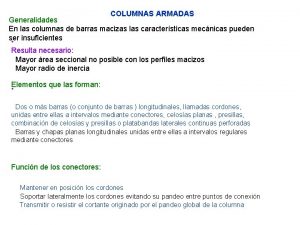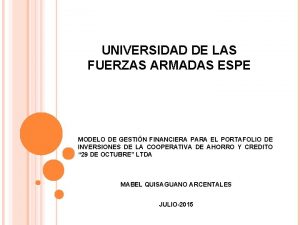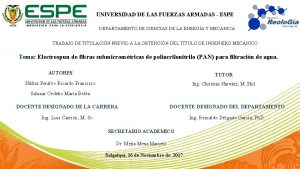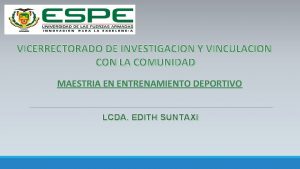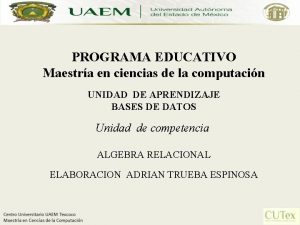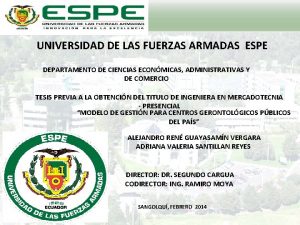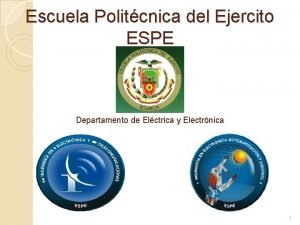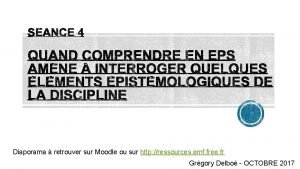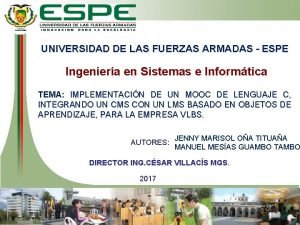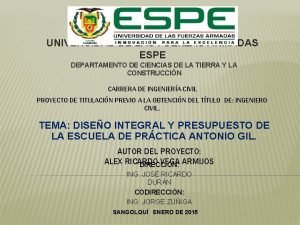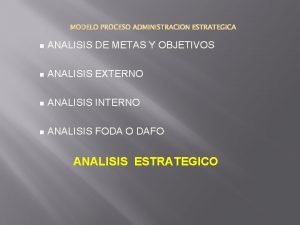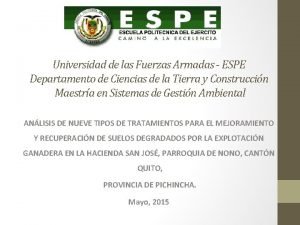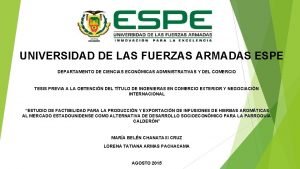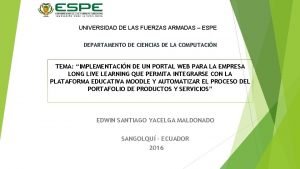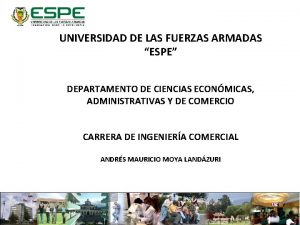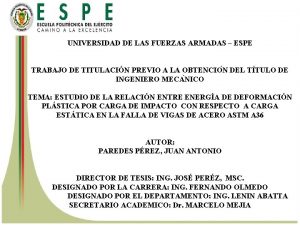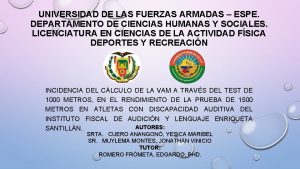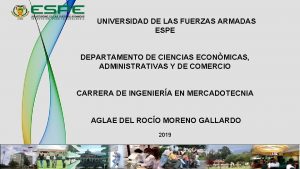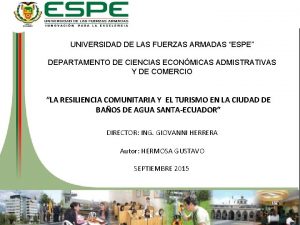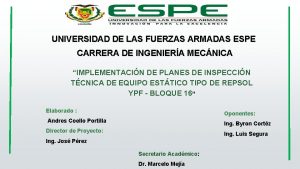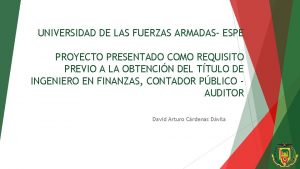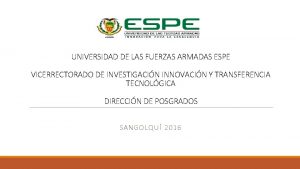UNIVERSIDAD DE LAS FUERZAS ARMADAS ESPE LANGUAGES DEPARTMENT






























- Slides: 30

UNIVERSIDAD DE LAS FUERZAS ARMADAS - ESPE LANGUAGES DEPARTMENT TITLE: USE OF COMMUNICATIVE LANGUAGE TEACHING METHODOLOGY AND ITS INFLUENCE IN DEVELOPING LISTENINGSPEAKING SKILLS IN STUDENTS OF 7º BASIC GRADE EDUCATION AT JAHIBE ELEMENTARY SCHOOL DURING SEPTEMBER – NOVEMBER 2012 TANIA MARILIS SANGOQUIZA CASTRO ADVISORS: MG. MARCOS MORALES. DIRECTOR MG. MONICA PINTO. CODIRECTOR AUGUST 2013

IDENTIFICATION OF THE PROBLEM Poor level of listened and spoken English Lack of confidence when speaking Underdeveloped skills

JUSTIFICATION Not updated methodology Lack of goals Classroom activities Formal/ informal speech

OBJECTIVES GENERAL OBJECTIVES To determine the efficiency of the Communicative Language Teaching Methodology in the learning of English Language To verify the level of development of listening and speaking skills in the students of seventh grade at JAHIBE Elementary School

Communicative Language Teaching Methodology

Communicative Language Teaching • What is CLT? • Communication in the target language. • Introduce authentic material. • Students' personal experiences • Relate the language learned in the classroom with activities outside.

Communicative Language Teaching Focus on the CLT approach Autonomy social environment meaning teachers co-learners

Listening and Speaking skills Listening and Speaking Skills Tips to improve listening comprehension: Getting audio in English with stories or conversations Watch TV programs or films in English Playing songs in English Work on increasing their vocabulary Talk with native English speakers

METHODOLOGICAL DESIGN Population and sample 40 students 5 teachers Setting JAHIBE school Instruments for data collection Surveys Pre and Post test Processing and statistical analysis of data

ANALYSIS OF RESULTS QUESTIONNARIE TO TEACHERS Do you use stories or writings about interesting topics to develop listening skills? 3 2. 5 2 Axis Title 1. 5 1 0. 5 0 Frequency Percent Always 0 Sometimes 2 Rarely 3 Never 0 0% 40% 60% 0%

ANALYSIS OF RESULTS QUESTIONNARIE TO TEACHERS Do you use T. V. programs or short videos to help improving the pronunciation of your students? 4 3 Axis Title 2 1 0 Series 1 Always 0 Sometimes 4 Rarely 1 Never 0 Series 2 0% 80% 20% 0%

ANALYSIS OF RESULTS QUESTIONNARIE TO TEACHERS Do you use easy language and clear pronunciation of cartoon movies to develop the listening and speaking skills of your students? Axis Title 4 3 2 1 0 Frequency Yes 1 No No 4 Percent 20% 80%

ANALYSIS OF RESULTS QUESTIONNARIE TO TEACHERS Do you use virtual readings and make activities to encourage the listening comprehension of your students? 2 1. 5 Axis Title 1 0. 5 0 Frequency Percent Always 0 Sometimes 2 Rarely 1 Never 2 0% 40% 20% 40%

ANALYSIS OF RESULTS QUESTIONNARIE TO TEACHERS Do you use the internet listening and speaking resources to develop the students' English knowledge? 4 3 Axis Title 2 1 0 Frequency Percent Always 1 Sometimes 4 Rarely 0 Never 0 20% 80% 0% 0%

ANALYSIS OF RESULTS QUESTIONNARIE TO STUDENT’S Are you encouraged to speak English in class? 20 Axis Title 10 0 Frequency Percent Yes 18 90% No No 2 10%

ANALYSIS OF RESULTS QUESTIONNARIE TO STUDENT’S Does your teacher use songs to practice listening and pronunciation during the class? 12 10 8 Axis Title 6 4 2 0 Frequency Percent Always 11 Sometimes 9 Rarely 0 Never 0 55% 45% 0% 0%

ANALYSIS OF RESULTS QUESTIONNARIE TO STUDENT’S Does your teacher use the easy language and clear pronunciation of cartoon movies to develop the listening and speaking skills? 20 15 Axis Title 10 5 0 Frequency Percent Yes 20 No No 0 100% 0%

ANALYSIS OF RESULTS QUESTIONNARIE TO STUDENT’S Does your teacher use the internet resources to encourage your English knowledge? 0% 0% 95% N ly R ar e es et im So m Percent Al w ay s Always Someti Rarely mes Frequency 0 0 19 Never 1 ev er 20 Axis Title 10 0 5%

ANALYSIS OF RESULTS QUESTIONNARIE TO STUDENT’S Do you like to have the opportunity to practice speaking with a native speaker? 15 Axis Title 10 5 0 Frequency Yes 15 No No 5 Percent 75% 25%

COMPARATIVE RESULT Series 1 PRE TEST 16 14 12 10 8 6 4 2 0 Series 1 Control Group 14. 5 Experimental Group 14. 5

POST TEST COMPARATIVE RESULT POST TEST 17. 5 17 Series 1 16. 5 16 15. 5 15 14 Series 1 Control Group 15 Experimental Group 17

TESTING THE HYPOTHESIS Working Hypotheses The use of communicative language teaching methodology helps effectively in developing listening-speaking skills in students of 7 º basic education. Tendency 20 18 16 Axis Title 14 12 10 8 6 4 2 0 1 2 3 4 5 6 7 8 9 10 11 12 13 14 15 16 17 18 19 20 Pre Test 15 8 9 11 13 10 8 7 12 12 11 12 14 15 13 5 6 8 15 12 Post Test 18 17 14 17 15 16 17 14 16 15 18 15 17 15 16 16 15 17 16 17

CONCLUCIONS The application of communicative language teaching methodology improved listening and speaking skills in the students, it was easily observed with the final results obtained. There are not enough technological tools in the institution to use them in the classroom in order to have a more dynamic class full of excitement and motivation to achieve the purpose of learning a foreign language. Students really enjoy the time devoted to the English class because teachers have the charisma to engage students, but this is not enough at the moment of the learning process. Teachers almost use the whiteboard most of the time, which seems to be boring for the students who want to have a more authentic and active class.

RECOMMENDATIONS I would recommend to apply the communicative language teaching methodology in the Institution to improve the students' listening and speaking skills, with a special teachers’ training in this methodology. The technological tools must be increased, specially in the English area because the current teaching needs to use TICs, web pages and technological devices to enhance students’ skills in a holistic way. Teachers should be motivated by the Institution with permanent trainings in the area. Teachers have to use a variety of tools to catch the students’ attention in class and get good results.

PROPOSAL TITLE IMPLEMENTATION OF COMUNICATIVE LANGUAGE TEACHING METHODOLOGY ACTIVITIES TO IMPROVE SPEAKING AND LISTENING SKILLS IN THE SEVENTH GRADE STUDENTS OF BASIC EDUCATION AT JAHIBE ELEMENTARY SCHOOL

OBJECTIVES General To implement brief videos and chants to help teachers to develop speaking and listening skills in students. Specific Objectives To encourage teachers to use and create different activities using didactic resources and authentic material To motivate students to develop the speaking and listening skills.

ACTIVITIES Activity 1. – Cards Showtime Objective. – To reproduce spoken language throughout the use of a card in order to improve vocabulary and fluency in a natural way. Process. - (Steps description)

Activity 2. – Watching short or brief videos Objective. – To develop the speaking skill through watching videos.

Activity 3. Brief chants or songs Objective. – To develop the listening and speaking skills through singing chants or songs.

THANK YOU
 Universidad de las fuerzas armadas espe
Universidad de las fuerzas armadas espe Ley organica de las fuerzas armadas 139-13
Ley organica de las fuerzas armadas 139-13 Fuerzas armadas
Fuerzas armadas Que son las fuerzas a distancia
Que son las fuerzas a distancia Esfuerzo de fluencia
Esfuerzo de fluencia Columnas
Columnas Modelo espe
Modelo espe Smoet vet espe en spek tekst
Smoet vet espe en spek tekst Medicina espe
Medicina espe Vinculacion con la sociedad uce
Vinculacion con la sociedad uce Logo biotecnologia espe
Logo biotecnologia espe Rogop espe
Rogop espe Logo biotecnologia espe
Logo biotecnologia espe Zitterpappel lateinischer name
Zitterpappel lateinischer name Pentaho espe
Pentaho espe Espe
Espe Espe
Espe Moodle espe lnf
Moodle espe lnf Espe arquitectura
Espe arquitectura Espe arquitectura
Espe arquitectura Espe arquitectura
Espe arquitectura Las fuerzas internas del mercado
Las fuerzas internas del mercado Fuerzas fisica 3 eso
Fuerzas fisica 3 eso Dipolo permanente
Dipolo permanente Representando fuerzas
Representando fuerzas Momento anti horario
Momento anti horario Preguntas sobre las 5 fuerzas de porter
Preguntas sobre las 5 fuerzas de porter Modelo de las 5 fuerzas de porter
Modelo de las 5 fuerzas de porter Teorema de las fuerzas vivas
Teorema de las fuerzas vivas Tercera ley de newton
Tercera ley de newton Modelo de las 5 fuerzas de porter
Modelo de las 5 fuerzas de porter





